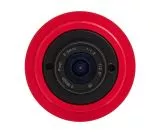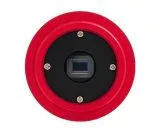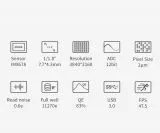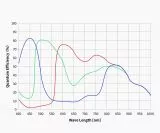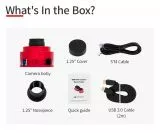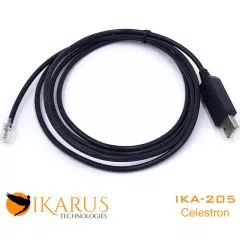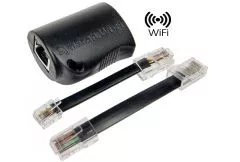- Details
- Mehr Bilder
- Kunden-Tipp
Produktbeschreibung
ZWO ASI678MM mono USB3.0 Astrokamera - Sensor D= 8,86 mm, 2,0 µm Pixelgröße
Die Kamera bietet eine sehr hohe Auflösung und ist für Mond- und Planetenfotografie, EAA und auch für Deep-Sky Astrofotografie verwendbar.
Diese Kamera ist mit einem modernen 1/1,8"-Sensor mit 3840*2160 Pixeln ausgestattet. Der IMX678 bietet neben der modernen Starvis-2-Technologie (Back-Illumination) ein extrem glattes Bild ohne Verstärkerglühen (Amp-Glow), überzeugt aber vor allem durch die extrem hohe Auflösung (2,0-µm-Pixel) und die hohe Bildrate. Wir empfehlen die Kamera unter anderem für:
Mond- und Planetenfotografie
Durch die feinen 2,0-µm-Pixel erreichen Sie bereits ab f/7 eine sehr hohe Auflösung, welches den Einsatz von Barlow- und Konvertersystemen überflüssig macht.EAA (elektronisch unterstützte Astronomie)
Die extrem hohe Auflösung, kombiniert mit einer hohen Bildfrequenz von 47,5 fps bei voller Auflösung (RAW8-Format), ermöglicht eine Echtzeitbeobachtung von Planeten sowie von Details auf Mond und Sonne. Beobachten Sie doch einfach mal gemeinsam in einer Gruppe - ohne langes Warten, bis jeder einmal an der Reihe war!Einsatz als Autoguider:
Die ASI678MM ist mit nur 126 Gramm ein Leichtgewicht. Sie belastet den Okularauszug kaum. Die Kamera bietet natürlich die als Standard geltende ST-4-Autoguidingschnittstelle. Ein 2 Meter langes Autoguidingkabel ist ebenfalls im Lieferumfang enthalten.Anti-Reflex-Klarglasfilter schützt den Sensor vor Staub
Der Klarglasfilter verhindert das Eindringen von Staub zum Sensor. Er lässt auch UV und Infrarot durch, so daß Sie auch Infrarotfotografie mit der Kamera betreiben können. Sie haben mit der richtigen Auswahl an Kontrastfiltern, Nebelfiltern, IR-Passfiltern oder UV/IR-Sperrfiltern die volle Kontrolle, welches Licht auf den Sensor fällt.Luftkühlung - reduziert die Sensortemperatur
Während der Aufnahmen erwärmt sich der Sensor. Durch das PCS wird die Wärme vom Sensor über ein Wärmeleitpad abgleitet. Die Sensortemperatur wird so um bis zu 15 Grad Celsius gegenüber Kameras ohne PCS reduziert.Hohe Empfindlichkeit für kurze Belichtungszeiten
Ein Vorteil der rückseitig beleuchteten CMOS-Sensors ist das geringere Ausleserauschen und die verbesserte Empfindlichkeit. Sony setzt beim IMX678-Sensor insbesondere die STARVIS-2-Technologie ein, die für eine hervorragende Sichtbarkeit bei geringer Beleuchtung sorgt. Sie können eine sehr hohe Lichtausbeute bei Astroaufnahmen erzielen und nicht nur im sichtbaren Licht, sondern auch im nahen Infrarotbereich (zur Verringerung des Seeings) eine hohe Bildqualität realisieren. Zusätzlich sorgt das geringe Ausleserauschen für einen größeren Dynamikbereich.Die ASI678MM ist nicht nur ideal für Planeten- und Detailaufnahmen von Sonne und Mond, sondern kann auch als Live-Streaming-Kamera oder als All-Sky-Kamera zur Beobachtung oder Überwachung der Wetterbedingungen eingesetzt werden.
Das geringe Rauschen und die Anti-Ampglow-Schaltung machen diese nicht! peltiergekühlte Kamera interessant für die Aufnahme von Deep-Sky-Objekten wie lichtschwachen Nebeln, Sternhaufen und Galaxien.
Der HCG-Modus:
Die Kamera verfügt über einen eingebauten HCG-Modus, der das Ausleserauschen bei hoher Verstärkung wirksam reduzieren kann und denselben großen Dynamikbereich beibehält, den Sie bei niedriger Verstärkung erwarten würden. Wenn die Verstärkung 182 beträgt, schaltet sich der HCG-Modus automatisch ein. Dies führt dazu, dass das Ausleserauschen unter 1,1 e- beträgt, während der Dynamikbereich immer noch ungefähr 12 Blendenstufen erreichen kann.Downloads, Treiber:
ZWO stellt Software und Treiber online zum freien Download zur Verfügung.Software und Treiber für alle ZWO-Kameras
Häufige Fragen rund um ZWO-Kameras:
Der FAQ-Bereich wird laufend von ZWO aktualisiert, hier findet man Antworten auf viele Fragen.FAQ rund um ZWO-Kameras
ZWO Users Forum
Anleitungen für ZWO-Produkte:
Die Seite wird laufend von ZWO aktualisiert, hier findet man Anleitungen für ZWO-Produkte.| Sensor: | Sony 1/1,8" CMOS IMX678AAQR1-C SW Sensor |
| Auflösung: | 3840*2160 Pixel, 8,29 Megapixel |
| Pixelgröße: | 2,0 µm |
| Sensorgröße: | 7,68 mm x 4,32 mm |
| Diagonale: | 8,86 mm (1/1,8") |
| Aufnahmegeschwindigkeit: | bis zu 47,5 FPS bei 10 bit |
| Belichtungszeit: | von 32 µs - 2000 s |
| ROI: | Unterstützt |
| ST4 Autoguider Port: | Ja |
| Abstand vom T2-Gewinde zum Sensor: | 12,5 mm |
| Shuttertyp: | Rolling Shutter |
| Schutzfenster: | AR beschichtet, voller IR Durchlass |
| Anschluss: | USB3.0/USB2.0 |
| QE: | ~83 % |
| Full well: | 11,27 ke- |
| Antiampglowschaltung: | Ja |
| Ausleserauschen: | 2,7 e- bis 0,6 e- |
| Bitauflösung: | 12 bit ADC |
| Teleskopanschluss: | M42x0,75 / 2" / 1,25" (über Adapter) |
| Stativgewinde: | 1/4" an der Rückseite |
| Abmessungen: | D 62 mm x 37,1 mm (ohne Objektiv) |
| Arbeitstemperatur: | -5 °C bis +50 °C |
| Systemanforderungen: | USB 3.0 sollte vom Betriebssystem unterstützt werden - ab Windows 8, Mac OS X 10.8, Linux Kernel 2.6.31 (ab Ubuntu 16.04) |
| Gewicht: | 126 g |
Kunden, die diesen Artikel kauften, haben auch folgende Artikel bestellt:
 Erklärungsbedürftig-kontaktieren
Erklärungsbedürftig-kontaktieren Auf Lager + Überprüfung
Auf Lager + Überprüfung Auf Lager + Überprüfung
Auf Lager + Überprüfung Auf Lager + Überprüfung
Auf Lager + Überprüfung Auf Lager + Überprüfung
Auf Lager + Überprüfung Lieferung erwartet
Lieferung erwartetDiesen Artikel haben wir am 22.04.2024 in unseren Katalog aufgenommen.
Profitieren Sie von unseren Erfahrungen als Teleskop-Spezialisten:
denn sehen heißt verstehen
in besonderen Fällen auch Vor-Ort-Service im Raum München

